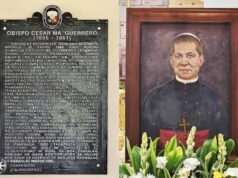COPYCAT, SECOND rate and trying hard of CamSur’s defining sports-recreational activity we could not care less, warmly welcoming news of a wakeboarding facility to be set up at the Sacobia, er, New Frontier.
Yeah, effusive was our praise to the Clark Development Corp. and the Philippine Tourism Authority for pump priming economic activities at what was once Clark’s bucolic sub-zone with the sport du jour that is drawing enthusiasts worldwide.
Yes, think of the hordes of European, American, Japanese wakeboarders – not to mention the legions of South Koreans – planing in through the Diosdado Macapagal International Airport and in less than 15 minutes flat – already in their boardshorts ready to take on the water. CamSur – all of an hour or so from the nearest international airport – could only weep.
Yes, think of serene Sacobia Lake hosting a multitude of nationalities, in a multitude of events spawning from wakeboarding.
Indeed, a most brilliant idea this wakeboarding project at Sacobia was. Or so we thought. And thought so wrongly.
No, it was not at the Sacobia Lake – as we presumed – that the wakeboarding facility would be built. It was somewhere upland.
So we learned from Oscar Dizon, Aeta tribal chief of Sitio San Martin, Bamban. Tarlac in the banner story of this paper Thursday headlined
Wakeboarding project endangers Aetas’reforestation area in Sacobia.
Striking terror right to our green core were Dizon’s fears that the wakeboarding project would encroach into four hectares of the Aetas reforestation project contracted with the Department of Environment and Natural Resources.
A body of water is essential, a sine qua non, to wakeboarding. That was precisely the basis of our presumption of Sacobia Lake as the site of this CDC-PTA project.
Upland Sacobia, what body of water exists but for the small creeks and rivulets usually fed only by the rains.
It is sound to assume now that PTA or whoever is its blessed contractor will have to dig a water body in its allotted 20-hectare area – the Aetas’ four hectares not excluded, if Dizon’s fears were correct. And this is where our worst fears lie. Sacobia serves as a watershed. As such, it has to be protected, preserved, and massively reforested. Not the least disturbed.
Any idiot would know that digging upland requires much more than simple slash-and-burn but the cutting and uprooting of vegetation, in the case of Sacobia, the reforested cover.
After the clearing, follows the damming that would store the water – pumped from underground, we presume – that would make the lake, the very arena for the sport.
There comes the damning. Stored water upland poses a clear and ever present danger to the lowlands, a break in the dams damns the lowland communities to sure death and destruction.
Shuddering is the thought of the Ormoc Tragedy transplanted to Sacobia.
For those who have either forgotten or simply refuse to remember, the Ormoc flash floods were recorded as “the most devastating and deadliest tragedy that struck the Philippines in modern history.”
News archives read: “In the morning of November 5, 1991, water from a heavy rainfall brought about by Typhoon Uring roared down from the surrounding hills carrying logs and uprooted trees, and engulfed Isla Verde and much of Ormoc City killing about 8,000 people.”
Prior to the disaster, loggers operating illegally stripped the mountains surrounding the affected settlement of their lush forest cover. Some tree stumps and other debris mixed with the soil and formed some makeshift dams that initially stored the rainwaters upland. With the continuing rain, the dams broke loose, bringing down death and destruction upon Ormoc.
Not simply a worst possible scenario at Sacobia. But a most probable one. And we shall know who to damn when, not if, it comes.
Yeah, effusive was our praise to the Clark Development Corp. and the Philippine Tourism Authority for pump priming economic activities at what was once Clark’s bucolic sub-zone with the sport du jour that is drawing enthusiasts worldwide.
Yes, think of the hordes of European, American, Japanese wakeboarders – not to mention the legions of South Koreans – planing in through the Diosdado Macapagal International Airport and in less than 15 minutes flat – already in their boardshorts ready to take on the water. CamSur – all of an hour or so from the nearest international airport – could only weep.
Yes, think of serene Sacobia Lake hosting a multitude of nationalities, in a multitude of events spawning from wakeboarding.
Indeed, a most brilliant idea this wakeboarding project at Sacobia was. Or so we thought. And thought so wrongly.
No, it was not at the Sacobia Lake – as we presumed – that the wakeboarding facility would be built. It was somewhere upland.
So we learned from Oscar Dizon, Aeta tribal chief of Sitio San Martin, Bamban. Tarlac in the banner story of this paper Thursday headlined
Wakeboarding project endangers Aetas’reforestation area in Sacobia.
Striking terror right to our green core were Dizon’s fears that the wakeboarding project would encroach into four hectares of the Aetas reforestation project contracted with the Department of Environment and Natural Resources.
A body of water is essential, a sine qua non, to wakeboarding. That was precisely the basis of our presumption of Sacobia Lake as the site of this CDC-PTA project.
Upland Sacobia, what body of water exists but for the small creeks and rivulets usually fed only by the rains.
It is sound to assume now that PTA or whoever is its blessed contractor will have to dig a water body in its allotted 20-hectare area – the Aetas’ four hectares not excluded, if Dizon’s fears were correct. And this is where our worst fears lie. Sacobia serves as a watershed. As such, it has to be protected, preserved, and massively reforested. Not the least disturbed.
Any idiot would know that digging upland requires much more than simple slash-and-burn but the cutting and uprooting of vegetation, in the case of Sacobia, the reforested cover.
After the clearing, follows the damming that would store the water – pumped from underground, we presume – that would make the lake, the very arena for the sport.
There comes the damning. Stored water upland poses a clear and ever present danger to the lowlands, a break in the dams damns the lowland communities to sure death and destruction.
Shuddering is the thought of the Ormoc Tragedy transplanted to Sacobia.
For those who have either forgotten or simply refuse to remember, the Ormoc flash floods were recorded as “the most devastating and deadliest tragedy that struck the Philippines in modern history.”
News archives read: “In the morning of November 5, 1991, water from a heavy rainfall brought about by Typhoon Uring roared down from the surrounding hills carrying logs and uprooted trees, and engulfed Isla Verde and much of Ormoc City killing about 8,000 people.”
Prior to the disaster, loggers operating illegally stripped the mountains surrounding the affected settlement of their lush forest cover. Some tree stumps and other debris mixed with the soil and formed some makeshift dams that initially stored the rainwaters upland. With the continuing rain, the dams broke loose, bringing down death and destruction upon Ormoc.
Not simply a worst possible scenario at Sacobia. But a most probable one. And we shall know who to damn when, not if, it comes.



